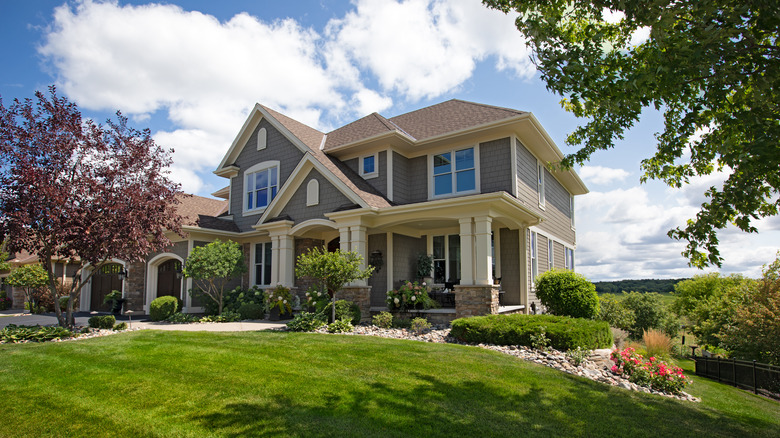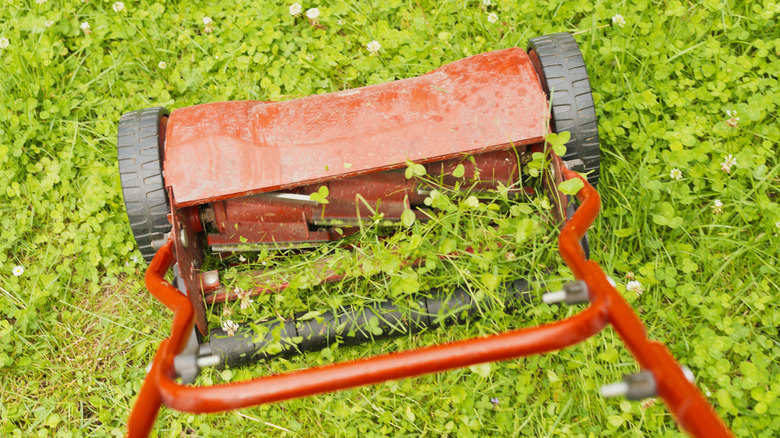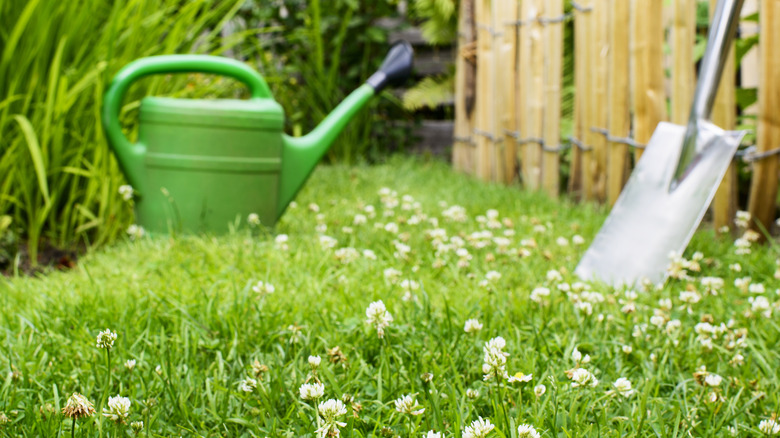What Are Mixed Lawns, And Are They Worth It?
Pristine and perfectly manicured lawns have long been viewed as an essential part of the American dream. The concept of the perfect lawn is evolving, though, as more homeowners consider the practical and environmental downsides of a monoculture of one type of turf grass. Mixed lawns, which feature a blend of different kinds of grasses and other mowable or low-growing plants, are quickly growing in popularity thanks to their lower maintenance and biodiversity benefits.
The challenges of maintaining a traditional lawn are no secret. They require regular watering, mowing, and fertilizing to look their best and avoid becoming patchy. Herbicides may even be required to maintain a uniform look and prevent weeds. Mistakes with aeration, pesticides, or even the height of your lawn mower blade can easily lead to you killing your grass without knowing it. Traditional turf grass monoculture isn't just exhausting and expensive to maintain; it also leaves pollinators without food sources and contributes to water waste. On the other hand, the benefits of mixed lawns are clear; here, we'll explain what makes them worth it.
The pros and cons of mixed lawns
While mixed lawns don't necessarily resolve all the issues of traditional lawns, depending on the mix of species used, they can be far lower maintenance and more drought resistant. Mixed grass lawns don't have to come at the expense of having a yard for kids to run around on. While some grass alternatives like chamomile and other ground cover plants cannot handle heavy foot traffic, using a mix of more rugged species can give you a beautiful, eco-friendly lawn without sacrificing usability.
One potential disadvantage of growing a mix of grasses and other plants in your lawn is balancing the different growth patterns of various species. When some grasses in your yard grow far faster than others, it can make mowing and other grass care more challenging and create an uneven look to the yard. Not everyone likes the aesthetics of mixed lawns either, but with the right mix of grasses, you can maintain the look of a traditional lawn while still reaping the benefits of mixed lawns. A study from The University of Florida found that using various cultivars of St. Augustine grass resulted in a healthier and less patchy lawn that was nearly indistinguishable from a more conventional lawn that only used one cultivar. Unfortunately for northern homeowners, St. Augustine grass is only hardy in zones 7 through 12, though the same concept of using different cultivars of the same species can be applied to other grasses as well.
Popular options for mixed lawns
One of the most popular eco lawn mixes, developed by Professor Tom Cook of Oregon State University, includes a mix of perennial ryegrass, clover, dwarf yarrow, fescue, daisies, and other mowable plants. It is currently available under the name PT 755 Fleur de Lawn. While not recommended for overseeding on existing lawns, it can be grown as either a mini-meadow or at a more traditional lawn length and is surprisingly durable and drought-tolerant. This mix also makes an excellent pollinator lawn thanks to the number of flowering plants included. The Smithsonian Gardens also provides a recipe for a mixed pollinator lawn using a combination of fescue, clover, strawberries, creeping thyme, and wild violets. Both these mixes require only occasional mowing and use far less water than conventional lawns.
While not every mixed lawn combination will work for every location, considering your yard's mix of sun and shade and your USDA zone, you can likely find or create the perfect blend of clovers, grasses, and low-growing flowering plants for your space. Another aspect to consider when putting together mixed lawns is the growing season of the different species. Many homeowners choose to grow a mix of both cool-season and warm-season grasses, allowing different species to shine at different times of year. This is especially beneficial in warmer climates, where annual ryegrass can take over for Bermuda grass or other warm-season grasses during the winter, ensuring year-round greenery.


